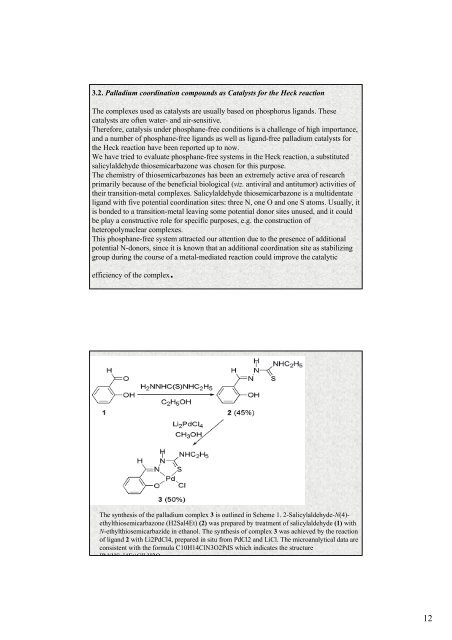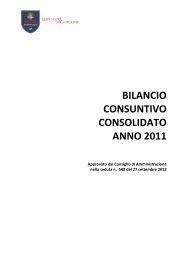Historical Perspective of the Heck Reaction
Historical Perspective of the Heck Reaction
Historical Perspective of the Heck Reaction
You also want an ePaper? Increase the reach of your titles
YUMPU automatically turns print PDFs into web optimized ePapers that Google loves.
3.2. Palladium coordination compounds as Catalysts for <strong>the</strong> <strong>Heck</strong> reaction<br />
The complexes used as catalysts are usually based on phosphorus ligands. These<br />
catalysts are <strong>of</strong>ten water- and air-sensitive.<br />
Therefore, catalysis under phosphane-free conditions is a challenge <strong>of</strong> high importance,<br />
and a number <strong>of</strong> phosphane-free ligands as well as ligand-free palladium catalysts for<br />
<strong>the</strong> <strong>Heck</strong> reaction have been reported up to now.<br />
We have tried to evaluate phosphane-free systems in <strong>the</strong> <strong>Heck</strong> reaction, a substituted<br />
salicylaldehyde thiosemicarbazone was chosen for this purpose.<br />
The chemistry <strong>of</strong> thiosemicarbazones has been an extremely active area <strong>of</strong> research<br />
primarily because <strong>of</strong> <strong>the</strong> beneficial biological (viz. antiviral and antitumor) activities <strong>of</strong><br />
<strong>the</strong>ir transition-metal complexes. Salicylaldehyde thiosemicarbazone is a multidentate<br />
ligand with five potential coordination sites: three N, one O and one S atoms. Usually, it<br />
is bonded to a transition-metal leaving some potential donor sites unused, and it could<br />
be play a constructive role for specific purposes, e.g. <strong>the</strong> construction <strong>of</strong><br />
heteropolynuclear complexes.<br />
This phosphane-free system attracted our attention due to <strong>the</strong> presence <strong>of</strong> additional<br />
potential N-donors, since it is known that an additional coordination site as stabilizing<br />
group during <strong>the</strong> course <strong>of</strong> a metal-mediated reaction could improve <strong>the</strong> catalytic<br />
efficiency <strong>of</strong> <strong>the</strong> complex.<br />
The syn<strong>the</strong>sis <strong>of</strong> <strong>the</strong> palladium complex 3 is outlined in Scheme 1. 2-Salicylaldehyde-N(4)ethylthiosemicarbazone<br />
(H2Sal4Et) (2) was prepared by treatment <strong>of</strong> salicylaldehyde (1) with<br />
N-ethylthiosemicarbazide in ethanol. The syn<strong>the</strong>sis <strong>of</strong> complex 3 was achieved by <strong>the</strong> reaction<br />
<strong>of</strong> ligand 2 with Li2PdCl4, prepared in situ from PdCl2 and LiCl. The microanalytical data are<br />
consistent with <strong>the</strong> formula C10H14ClN3O2PdS which indicates <strong>the</strong> structure<br />
[Pd(HSal4Et)Cl] H2O<br />
12








